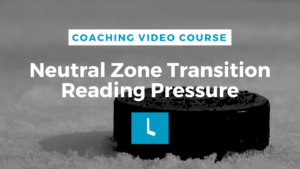(Transcribed from How to Play Hockey: Our Minor Hockey Coaching Course.)
When you’re on defense and the other team has the puck, you want to prevent the attack as much as possible. So here’s a classic example of Holding the Line…
Example: D-Zone
- D1 and D2 are backing up and taking on a three on two attack. If they don’t hold the line and back in to far they may allow the attacking FWD to have space to get that shot off which means our D have been very ineffective.
- The D want to have as close a gap or a space between them and the attacking FWD when just above the blueline.You’re goal is trying to stall, defend and prevent the attacking team from crossing the blue line with speed.
- While the D are trying to apply some kind of pressure and be aggressive they’re hoping for back checking pressure by their own FWD’s and hopefully they can break up the play in the neutral zone.
Example: O-Zone
- The same would apply in the offensive zone.
- These D want to hold the line and prevent the breaking out team from getting over the blue line.
- In order to do so they really need help from their high FWD or F3 to be able to apply pressure on the puck carrier so that hopefully we can knock a puck loose.
- This allows the D to get the puck and keep it in.
- We don’t want to just leave the zone and give the breaking out team an easy exit. We want to hold the line and prevent and then again in the neutral zone as well to hold the line and prevent the entry.
Looking to download half ice hockey practice plans, goalie drills for teams (not a goalie coach?!) or small area games drills? We’ve got you covered too. Click here. Perfect for recreational level coaches.





